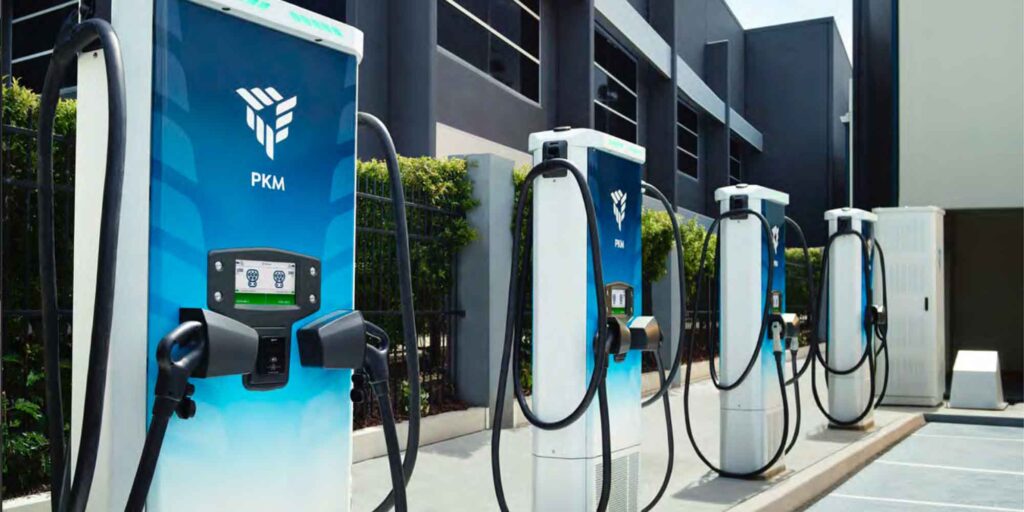Understanding the Biden Administration’s $5 Billion EV Charging Infrastructure Program
President Biden recently announced the new National Electric Vehicle Infrastructure (NEVI) Formula Program which will provide nearly $5 Billion of tax dollars over five years to help states create a network of EV charging stations. Funds will be rolled out along designated Alternative Fuel Corridors, particularly the Interstate Highway System.

The 5-year plan has received wide bipartisan support and represents the most significant investment in electronic vehicles by the U.S government to date. Read on to understand how the current administration will roll out such a large infrastructure plan and how it will affect local communities.
How will funding be rolled out?
The total $5 billion will be allocated in yearly grants to states over five years and the Biden administration has insisted on the developmental goal of supporting 500,000 chargers by 2030. The yearly rollout of funds is as follows:
– The National Electric Vehicle Infrastructure (NEVI) Formula Program driving the Biden’s administrations’ EV program will make $615 million available to states in the fiscal year 2022.
– A further $2.5 billion competitive grant program will be issued to states in the fiscal year of 2023.
– Further investments that amount to $3 billion will be allocated through 2026. Still, industry experts have noted that it would take more than $50 billion to shift the auto industry to fully electric vehicles.
– Further regulations on, what communities will receive funding, is also outlined stating that 40% of benefits from the federal investment must flow to disadvantaged communities.
How do states access funds?
Local jurisdictions should consider developing electric vehicle charging plans to compete for federal grants designed to expand EV charging in not only major corridors but also cities and counties. To qualify, each state’s department of transport (DOT) will have to first develop an infrastructure plan in association with the state’s respective DOE. The infrastructure plans must be submitted to the new Joint Office of Energy and Transportation to access the funds, led by US DOE and US DOT.
According to the NEVI guidance, states have to submit their plans to the joint office before 1st August 2022. The Federal Highway Administration (FHWA) will review and potentially pass them by 30th September. On may the 13th, the FHWA will publish regulatory proposals addressing minimum standards and requirements.
There is a lot each state can do to prepare for the electric vehicles and DC fast charging (DCFC) infrastructure. The office has launched a brand-new website, Driveelectric.gov, to provide tools, data and extend technical assistance to states. $615 million has already been allocated to states for this year’s electric vehicle project.
What type of Electric Vehicle Supply Equipment EVSE Qualifies For Funding?
The administration’s proposed guidelines for the type of charging equipment that is covered under the NEVI Program.
– All NEVI EV charge infrastructure installed will be Direct-Current (DC) fast chargers.
– Stations should be designed to provide at least four ports to charge four EVs simultaneously.
– Station power capability should be at least 600kW per DC port at 150 kW or greater.
– 350 kW or greater per station power capacity is encouraged
– Station designs should consider the potential for future expansions to support the electrification and charging demands of medium- and heavy-duty trucks which are responsible for a bulk of carbon emissions.
Why the sudden urgency?
Despite the recent rise in sales of EVs in the mainland United States, the transportation sector is still one of the most significant contributors to greenhouse gas emissions. President Biden has been keen on reducing carbon emissions during his presidency, and electrifying the transportation industry is a substantial component of this goal.
The fuel-based transportation industry is responsible for a third of all carbon emissions, which is a significant portion. Biden’s administration launched the five-year plan to help meet the global agenda for electrification and climate change commitments.
Beyond the Initial $5 Billion in Funding
Another $2.5 billion is earmarked as part of a discretionary grant program for infrastructure for corridor and community charging.
“The other discretionary programs are to fill the gaps within the system,” said Coral Torres, senior adviser at the Federal Highway Administration, explaining how the $2.5 billion will be used. “To make sure we provide that infrastructure to communities across the country — rural areas, disadvantaged communities and urban areas as well — that might not have access to this infrastructure.”
The competitive grant program is open to local governments, which can apply directly for the funding. This program is unlike the National Electric Vehicle Infrastructure (NEVI) Formula Program, which will help states establish their EV charging plans.
What DC Fast Charging Companies Are Leading The Way?
On February 8th, the president announced that Tritium LTD, a DC fast-charging hardware and software manufacturer, will be breaking ground on their first US manufacturing locations. The plant will feature six production belts that will produce up to 30,000 American-made DC fast chargers per year, creating many local jobs in the process too.
The white house also announced various details of the EV charging infrastructure plan. Siemens will be working alongside companies like ABB that deal in the production of transit bus chargers and DC fast chargers. These companies will expand their US EV charging manufacturing operations over the next five years creating thousands of American jobs.
The Future Is Electric
The funding for charging infrastructure and the momentum it’s generating is also opening the door for lasting policy goals in areas like EV readiness ordinances. Politicians and policymakers have put aside party lines and recognized the urgent need for climate change reform. The U.S. Transportation Secretary Pete Buttigieg can be quoted saying, “a century ago, America pioneered innovations in the modern automotive industry; now America must lead the charge towards electric vehicles, no pun intended. The infrastructure law gives the United States a competitive advantage in the EV adoption rate.” By streamlining working with local and state governments, labor, and the private sector, Biden’s administration is making EV charging accessible for more Americans.
About the Author
Robb Monkman is a mission-driven entrepreneur who is passionate about making the world a better place. Robb is a serial entrepreneur with experience launching multiple hardware and software products at early-stage companies. Robb is an active angel investor and advisor helping companies that are making a positive impact in clean energy, electrification, and IoT.
Written by Robb Monkman
